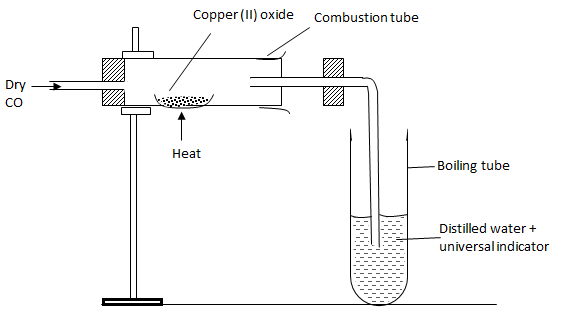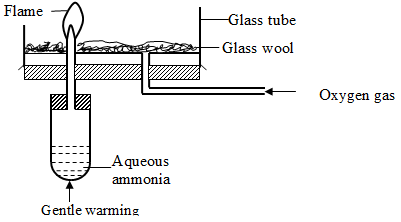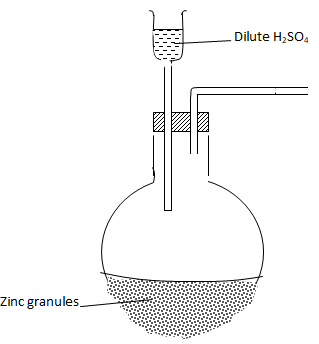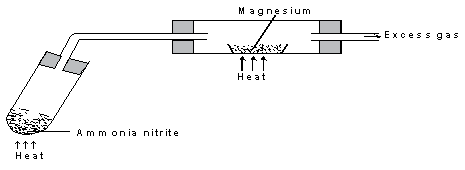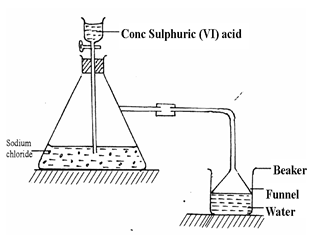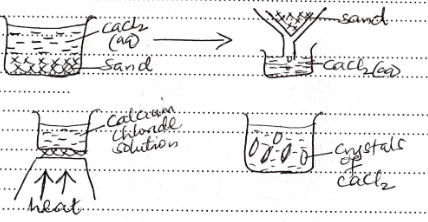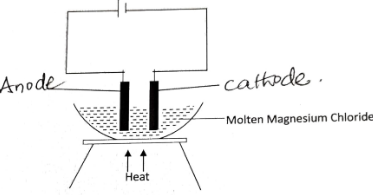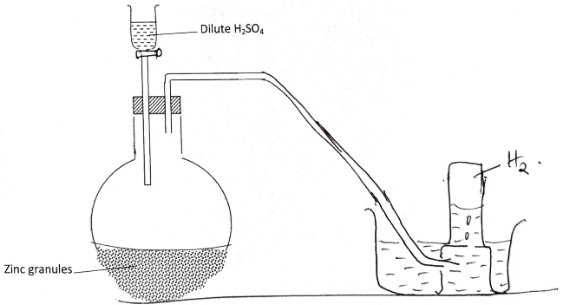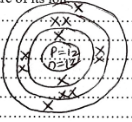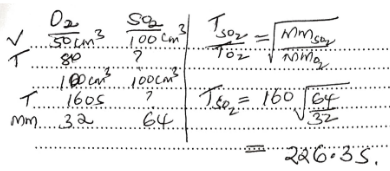INSTRUCTIONS TO THE CANDIDATES:-
- Answer all the questions in the spaces provided.
- Mathematical tables and electronic used calculators may be
- All working MUST be clearly shown where necessary.
- Matter exists in three states which can be related as shown in the diagram below.
Name processes: P: ………………………………………… (1mk)
R: ………………………………………………….. (1mk) -
- Give one reason some of the laboratory apparatus are made of ceramics. (1 mark)
- Name two apparatus that can be used to measure approximately 75 cm of dilute sulphuric (VI) acid. (2 marks)
- Draw the procedural set-ups that can be used to separate a mixture of sand and calcium chloride to obtain crystals of calcium chloride. (3 marks)
- State two applications of chromatography. (2 marks)
-
The above set-up was used to determine the chemical properties of carbon (II) oxide.- Write the chemical equation for the reaction taking place in the combustion tube. (1 mark)
- State and explain the observation made in the boiling tube. (2 marks)
- A student placed some hydrogen peroxide in a test tube then added a small amount of Solutions can be classified as acids, bases or neutral. The table below shows solutions and their pH values
Solution pH - values K 1.5 L 7.0 M 14.0 - Select any pair that would react to form a solution of pH 7 (1 Mark)
- Identify two solutions that would react with aluminium hydroxide. Explain (2 Marks)
- 9.12g of a gaseous compound contains 8g of silicon while the rest is hydrogen. Determine the empirical formula of the compound. (H = 1, Si = 28) (3 Marks)
- Study the set-up below and answer the questions that follow.
- Why is aqueous ammonia warmed gently? (1 Mark)
- What is the colour of the flame? (1 Mark)
- Write the chemical equation for the reaction that takes place (1Mark)
-
- Chlorine can be prepared in the laboratory by using the following reagents and chemicals. Concentrated sulphuric (VI) acid, water, manganese (IV) oxide, concentrated hydrochloric acid.
- State the role of concentrated sulphuric (VI) acid. (1 mark)
- Write the equation for formation of chlorine. (1 mark)
- What is the role of manganese (IV) oxide? (1 mark)
- Chlorine can be prepared in the laboratory by using the following reagents and chemicals. Concentrated sulphuric (VI) acid, water, manganese (IV) oxide, concentrated hydrochloric acid.
-
- State Boyle’s law. (1 mark)
- A gas occupies 270cm3 at a pressure of 660mmHg at 37°C. What is the new volume if pressure is changed to 810 mmHg at 63°C? (2 marks)
- An organic compound contain s 24.24% carbon, 4.04% hydrogen and the rest chlorine. If its relative molecular mass is 99, what is its molecular formula? (3 marks)
(C = 12, H = 1, Cl = 35.5) - A given mass of sodium nitrate was heated completely and 320cm3 of the gas was produced at s.t.p. Determine the mass of the sodium nitrate heated.
(Na = 23. N = 14, O = 16, molar gas volume = 22.4L) (3 marks) -
- Give one advantage of using methyl orange over phenolphthalein as an indicator. (1 mark)
- Three drops of litmus solution was added to 20cm3 of 2M hydrochloric acid in a beaker followed by 20cm3 of 2M ammonium hydroxide. State and explain the observation made. (2 marks)
- Study the flow chart below and answer the questions that follow.
- Identify solid G………………………………………………………………… (1mk)
- Write a balanced chemical equation between the yellow solid and dilute nitric acid. (1mk)
- Study the diagram below and answer the questions that follow.
- Define the term electrolysis. (1 mark)
- On the diagram, label the Anode and Cathode. (2 marks)
- Write the equation at the anode. (1 mark)
- In order to find the proportion by volume of gases in air, a sample of air was passed through two wash bottles, the first containing sodium hydroxide solution and the second containing concentrated sulphuric (VI) acid. The remaining gas was then collected in a syringe.
- Why was the air passed through;
- sodium hydroxide solution? (1 mark)
- concentrated sulphuric (VI) acid? (1 mark)
- Name is the major gas collected in the syringe. (1 mark)
- Why was the air passed through;
- During the manufacture of sodium carbonate in the industry.
- Give the name of the process to manufacture sodium carbonate. (1 mark)
- Write the final equation to form sodium carbonate during the process. (1 mark)
- Give one use of sodium carbonate. (1 mark)
- Describe how to prepare crystal of magnesium sulphate starting with magnesium powder.(3mks)
-
- Complete the diagram below to show how dry sample of hydrogen gas is prepared in the laboratory. (2 marks)
- Name the catalyst which could be used to increase the reaction rate of production of hydrogen gas in the set up drawn above. (1 mark)
- Complete the diagram below to show how dry sample of hydrogen gas is prepared in the laboratory. (2 marks)
- An element consists of two isotopes with atomic masses 59 and 61 in the ratio of 3 : 2 respectively.
- What are isotopes? (1 mark)
- Calculate the relative atomic mass of the element. (2 marks)
- An element:
- To which chemical family does it belong? (1 mark)
- Write the electron arrangement of the atom. (1 mark)
- Draw the structure of its ion. (1 mark)
- If 25cm3 of 0.1M H2SO4 solution neutralized a solution contain 1.06g of sodium carbonate in 250cm3 of solution, calculate the morality and volume of sodium carbonate solution. (Na = 23, O = 16, C = 12) (3 Marks)
- 50cm3 of oxygen gas diffused through a porous plug in 80 seconds. How long will it take 100cm3 of sulphur (IV) oxide to diffuse through the same plug? (S = 32, o = 16) (3 Marks)
-
- State the role of the following parts during fractional distillation of a mixture of water and ethanol
- Glass beads in the fractionating column (1 Mark)
- Fractionating column (1 Mark)
- State any one application of fractional distillation (1 Mark)
- State the role of the following parts during fractional distillation of a mixture of water and ethanol
-
- State what is observed when sodium hydroxide pellets are left in air overnight.(1 mark)
- What name is given the process shown by the salt in (a) above? (1 mark)
- Given;
- Identify;
Solid F - …………………………………………………………………………. (1 mark)
Solid J - …………………………………………………………………………… (1 mark) - Write equation for step 1. (1 mark)
- Identify;
- Use dot (•) and cross (X) to show the bonding in Lithium oxide. (2 mark)
- Excess magnesium ribbon was burnt in air to form a white solid mixture. Write two equations to show the formation of the white solid mixture. (2 marks)
- The set-up below shows how gas A was prepared and reacted with heated magnesium
- Give a reason why it is not advisable to heat magnesium before heating ammonium nitrite. (1mk)
-
- Identify gas A ....................................................................... (1mk)
- Write a chemical equation for the reaction between gas A and magnesium (1mk)
- Study the set-up below and answer questions that follow.
- Name the gas that is produced when concentrated sulphuric (VI) acid reacts with the sodium chloride (1 mark)
- Why is it necessary to use a funnel in the beaker? (1 mark)
- How does the gas affect the PH of the water in the beaker? (1 mark)

MARKING SCHEME
- Matter exists in three states which can be related as shown in the diagram below.
Name processes: P: ……Evaporation…………………………………… (1mk)
R: …………Condensation/ freezing……………………………………….. (1mk) -
- Give one reason some of the laboratory apparatus are made of ceramics. (1 mark)
- Because they do not react with laboratory chemicals.
- Name two apparatus that can be used to measure approximately 75 cm of dilute sulphuric (VI) acid. (2 marks)
- Measuring cylinder
- Burette
- Beaker
- Give one reason some of the laboratory apparatus are made of ceramics. (1 mark)
- Draw the procedural set-ups that can be used to separate a mixture of sand and calcium chloride to obtain crystals of calcium chloride. (3 marks)
- State two applications of chromatography. (2 marks)
- To identify banned substances in sports.
- To test for drug purity
- To identify contaminants in foods and drinks.
- To identify harmful substnaces in cosmetics.
-
The above set-up was used to determine the chemical properties of carbon (II) oxide.- Write the chemical equation for the reaction taking place in the combustion tube. (1 mark)
CO(g) + CuO(s) → Cu(s) + CO2(g) - State and explain the observation made in the boiling tube. (2 marks)
- Colour of CuO changes from black to browm copper
- Write the chemical equation for the reaction taking place in the combustion tube. (1 mark)
- A student placed some hydrogen peroxide in a test tube then added a small amount of Solutions can be classified as acids, bases or neutral. The table below shows solutions and their pH values
Solution pH - values K 1.5 L 7.0 M 14.0 - Select any pair that would react to form a solution of pH 7 (1 Mark)
- K and M
- Identify two solutions that would react with aluminium hydroxide. Explain (2 Marks)
- K and M because aluminium hydroxide is amphoteric hydroxide.
- Select any pair that would react to form a solution of pH 7 (1 Mark)
- 9.12g of a gaseous compound contains 8g of silicon while the rest is hydrogen. Determine the empirical formula of the compound. (H = 1, Si = 28) (3 Marks)
Si H
8 1.12
8/28 1.12/1
0.286 1.12
0.286 0.286
1 4
= SiH4 - Study the set-up below and answer the questions that follow.
- Why is aqueous ammonia warmed gently? (1 Mark)
- To produce ammonia vapours /gas
- What is the colour of the flame? (1 Mark)
- green-yellow flame
- Write the chemical equation for the reaction that takes place (1Mark)
- 4NH3(g) + 3O2(g) → 2N2(g) + 6H2O(g)
- Why is aqueous ammonia warmed gently? (1 Mark)
-
- Chlorine can be prepared in the laboratory by using the following reagents and chemicals. Concentrated sulphuric (VI) acid, water, manganese (IV) oxide, concentrated hydrochloric acid.
- State the role of concentrated sulphuric (VI) acid. (1 mark)
- Drying agent
- Write the equation for formation of chlorine. (1 mark)
- MnO2(s) + 4HCl(l) → MnCl2(aq) + H2O(l) + Cl2(g)
- What is the role of manganese (IV) oxide? (1 mark)
- Oxidising agent
- State the role of concentrated sulphuric (VI) acid. (1 mark)
- Chlorine can be prepared in the laboratory by using the following reagents and chemicals. Concentrated sulphuric (VI) acid, water, manganese (IV) oxide, concentrated hydrochloric acid.
-
- State Boyle’s law. (1 mark)
- The volume of a given mass of gas is inversely propotional to its pressure at constant temperature.
- A gas occupies 270cm3 at a pressure of 660mmHg at 37°C. What is the new volume if pressure is changed to 810 mmHg at 63°C? (2 marks)
V1 = 270cm3 V2 =?
P1 = 660mmHg P2 = 810mmHg
P1V1 = P2V2
270 × 660 = 810V2
V2 = 270 × 660
810
V2 = 220cm3
- State Boyle’s law. (1 mark)
- An organic compound contain s 24.24% carbon, 4.04% hydrogen and the rest chlorine. If its relative molecular mass is 99, what is its molecular formula? (3 marks)
(C = 12, H = 1, Cl = 35.5)
C H Cl
24.24 4.04 71.72
12 1 35.52
2.02 4.04 2.02
2.02 2.02 2.02
1 2 1
E.F CH2Cl
(CH2Cl) × n = 99
49.5n = 99
n = 99
49.5
n = 2
M.F C2H4Cl2 - A given mass of sodium nitrate was heated completely and 320cm3 of the gas was produced at s.t.p. Determine the mass of the sodium nitrate heated.
(Na = 23. N = 14, O = 16, molar gas volume = 22.4L) (3 marks)
2NaNO32NaNO2 + O2
2 2 1
Moles of gas
1mole = 22400cm3
= 320cm3
320 = 0.0143
22400
0.0143 × 2 = 0.0286 moles of NaNO3
Mass of NaNO3 = 0.0286 × 85
= 2.431g -
- Give one advantage of using methyl orange over phenolphthalein as an indicator. (1 mark)
- Methyl orange is used in neutralization and reaction between carbonates and dil. acids while phenolphthalein is used in neutralization only.
- Three drops of litmus solution was added to 20cm3 of 2M hydrochloric acid in a beaker followed by 20cm3 of 2M ammonium hydroxide. State and explain the observation made. (2 marks)
- The colour changes from colourless to pink to the neutralization reaction (formation of NH4Cl)
- Give one advantage of using methyl orange over phenolphthalein as an indicator. (1 mark)
- Study the flow chart below and answer the questions that follow.
- Identify solid G………………………………………………………………… (1mk)
- Lead (II) Nitrate
- Write a balanced chemical equation between the yellow solid and dilute nitric acid. (1mk)
- PbO(s) + 2HNO3(aq) →Pb(NO3)2(aq) + H2O(l)
- Identify solid G………………………………………………………………… (1mk)
- Study the diagram below and answer the questions that follow.
- Define the term electrolysis. (1 mark)
- Is the process of decomposing an electrolyte by passing an electric current.
- On the diagram, label the Anode and Cathode. (2 marks)
- Write the equation at the anode. (1 mark)
- 2Cl−(l) → Cl2(g) + 2e−
- Define the term electrolysis. (1 mark)
- In order to find the proportion by volume of gases in air, a sample of air was passed through two wash bottles, the first containing sodium hydroxide solution and the second containing concentrated sulphuric (VI) acid. The remaining gas was then collected in a syringe.
- Why was the air passed through;
- sodium hydroxide solution? (1 mark)
- To remove carbon (IV) oxide
- concentrated sulphuric (VI) acid? (1 mark)
- To absorb water vapour/ remove water vapour
- sodium hydroxide solution? (1 mark)
- Name is the major gas collected in the syringe. (1 mark)
- Nitrogen
- Why was the air passed through;
- During the manufacture of sodium carbonate in the industry.
- Give the name of the process to manufacture sodium carbonate. (1 mark)
- Solvay process
- Write the final equation to form sodium carbonate during the process. (1 mark)
- 2NaHCO3(s)
Na2CO3(s) + CO2(g) + H2O(l)
- 2NaHCO3(s)
- Give one use of sodium carbonate. (1 mark)
- Manufacture of glass
- Softening of water
- Give the name of the process to manufacture sodium carbonate. (1 mark)
- Describe how to prepare crystal of magnesium sulphate starting with magnesium powder.(3mks)
- React excess magnesium powder with dil. sulphuric acid to obtain magnesium sulphate
- Filter to obtain the filtrate
- Heat the filtrate to saturation and allow it to cool to obtain the crystals.
- Dry the crystals between two filter papers.
-
- Complete the diagram below to show how dry sample of hydrogen gas is prepared in the laboratory. (2 marks)
- Name the catalyst which could be used to increase the reaction rate of production of hydrogen gas in the set up drawn above. (1 mark)
- Crystals of Copper (II) Sulphate.
- Complete the diagram below to show how dry sample of hydrogen gas is prepared in the laboratory. (2 marks)
- An element consists of two isotopes with atomic masses 59 and 61 in the ratio of 3 : 2 respectively.
- What are isotopes? (1 mark)
- Are atoms with the same atomic number but different mass number
- Calculate the relative atomic mass of the element. (2 marks)
59 × 3 + 61 × 2
2+3
177 + 122
5
299
5
= 59.8
- What are isotopes? (1 mark)
- An element:
- To which chemical family does it belong? (1 mark)
- Alkaline Earth Metal
- Write the electron arrangement of the atom. (1 mark)
- 2.8.2
- Draw the structure of its ion. (1 mark)
- To which chemical family does it belong? (1 mark)
- If 25cm3 of 0.1M H2SO4 solution neutralized a solution contain 1.06g of sodium carbonate in 250cm3 of solution, calculate the morality and volume of sodium carbonate solution. (Na = 23, O = 16, C = 12) (3 Marks)
Molarity of Na2CO3
1.06 × 4 = 4.24
106 106
=0.04M
Na2CO3 + H2SO4 → Na2CO3 + CO2 + H2O
1 1
Moles of H2SO4
25 × 0.1
1000
= 0.0025 moles
Vol = 0.0025 × 1000
0.04
= 62.5cm3 - 50cm3 of oxygen gas diffused through a porous plug in 80 seconds. How long will it take 100cm3 of sulphur (IV) oxide to diffuse through the same plug? (S = 32, o = 16) (3 Marks)
-
- State the role of the following parts during fractional distillation of a mixture of water and ethanol
- Glass beads in the fractionating column (1 Mark)
- To increase the surface area for condensation
- Fractionating column (1 Mark)
- Is to allow water vapour to condense into liquid and flow back into the flask
- Glass beads in the fractionating column (1 Mark)
- State any one application of fractional distillation (1 Mark)
- Distillation of crude oil
- Recycling of used oil
- Fractional distillation of liquid air to manufacture nitrogen and oxygen.
- State the role of the following parts during fractional distillation of a mixture of water and ethanol
-
- State what is observed when sodium hydroxide pellets are left in air overnight.(1 mark)
- It wets up/ absorbs water to form a solution.
- What name is given the process shown by the salt in (a) above? (1 mark)
- Deliquescence
- State what is observed when sodium hydroxide pellets are left in air overnight.(1 mark)
- Given;
- Identify;
Solid F - …………………………Copper (II) Carbonate………………………………………………. (1 mark)
Solid J - ……………………Copper (II) Sulphate……………………………………………………… (1 mark) - Write equation for step 1. (1 mark)
- CuCO3(s)
CuO(s) + CO2(g)
- CuCO3(s)
- Identify;
- Use dot (•) and cross (X) to show the bonding in Lithium oxide. (2 mark)
Li2O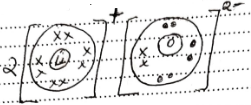
- Excess magnesium ribbon was burnt in air to form a white solid mixture. Write two equations to show the formation of the white solid mixture. (2 marks)
2Mg(s) + O2(g) → 2MgO(s)
3Mg(s) + N2(g) → Mg3N2(s) - The set-up below shows how gas A was prepared and reacted with heated magnesium
- Give a reason why it is not advisable to heat magnesium before heating ammonium nitrite. (1mk)
- Because it will be oxidised by oxygen in the combustion tube
-
- Identify gas A ............Nitrogen gas............................ (1mk)
- Write a chemical equation for the reaction between gas A and magnesium (1mk)
- 3Mg(s) + N2(g) → Mg3N2(s)
- Give a reason why it is not advisable to heat magnesium before heating ammonium nitrite. (1mk)
- Study the set-up below and answer questions that follow.
- Name the gas that is produced when concentrated sulphuric (VI) acid reacts with the sodium chloride (1 mark)
- Hydrogen Chloride gas
- Why is it necessary to use a funnel in the beaker? (1 mark)
- To increase the surface of absorption
- How does the gas affect the PH of the water in the beaker? (1 mark)
- The pH reduces
- Name the gas that is produced when concentrated sulphuric (VI) acid reacts with the sodium chloride (1 mark)
Join our whatsapp group for latest updates
Tap Here to Download for 50/-
Get on WhatsApp for 50/-
Download Chemistry Paper 1 Questions and Answers - Form 4 Term 1 Opener Exams 2023.
Tap Here to Download for 50/-
Get on WhatsApp for 50/-
Why download?
- ✔ To read offline at any time.
- ✔ To Print at your convenience
- ✔ Share Easily with Friends / Students


